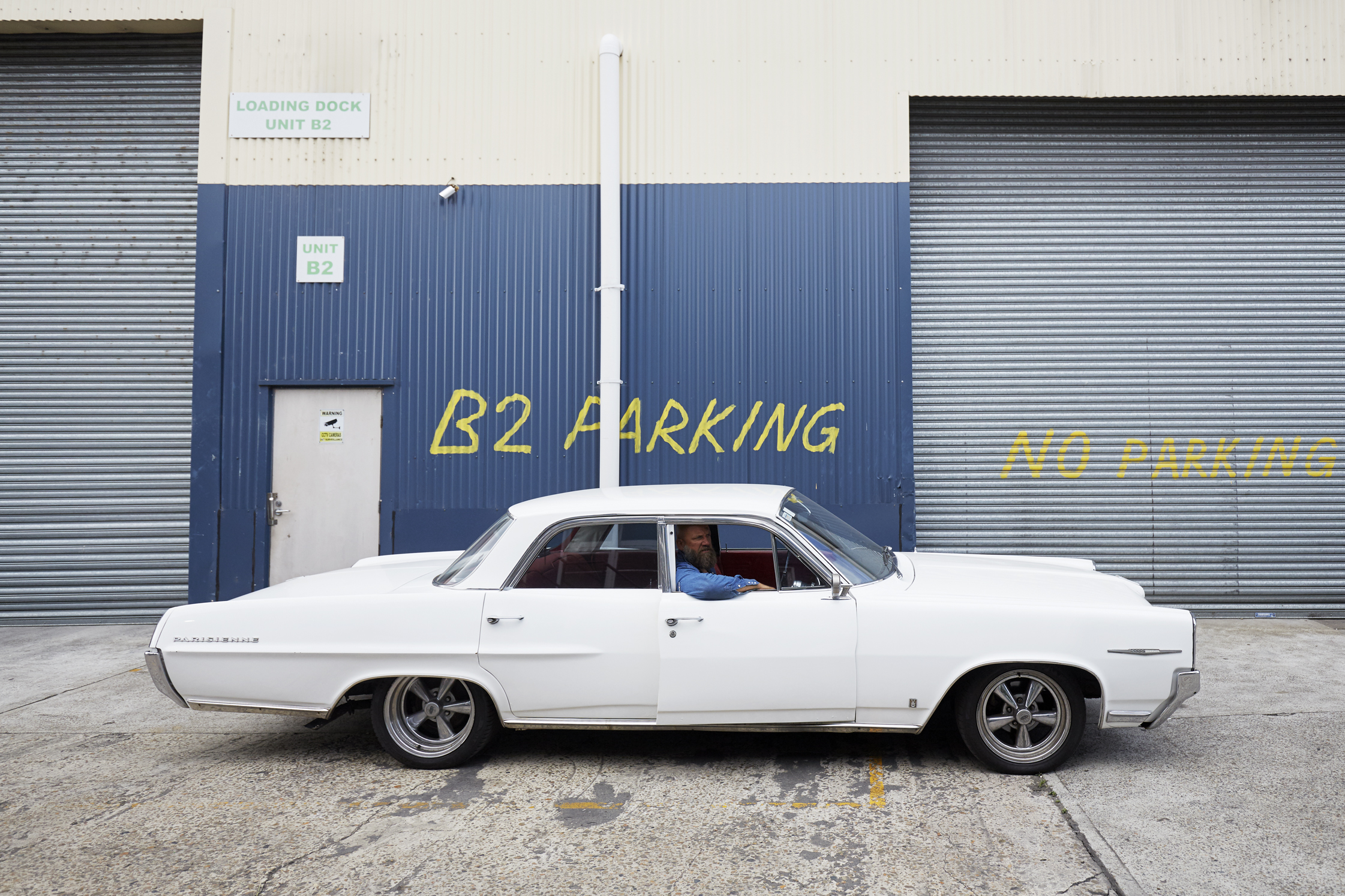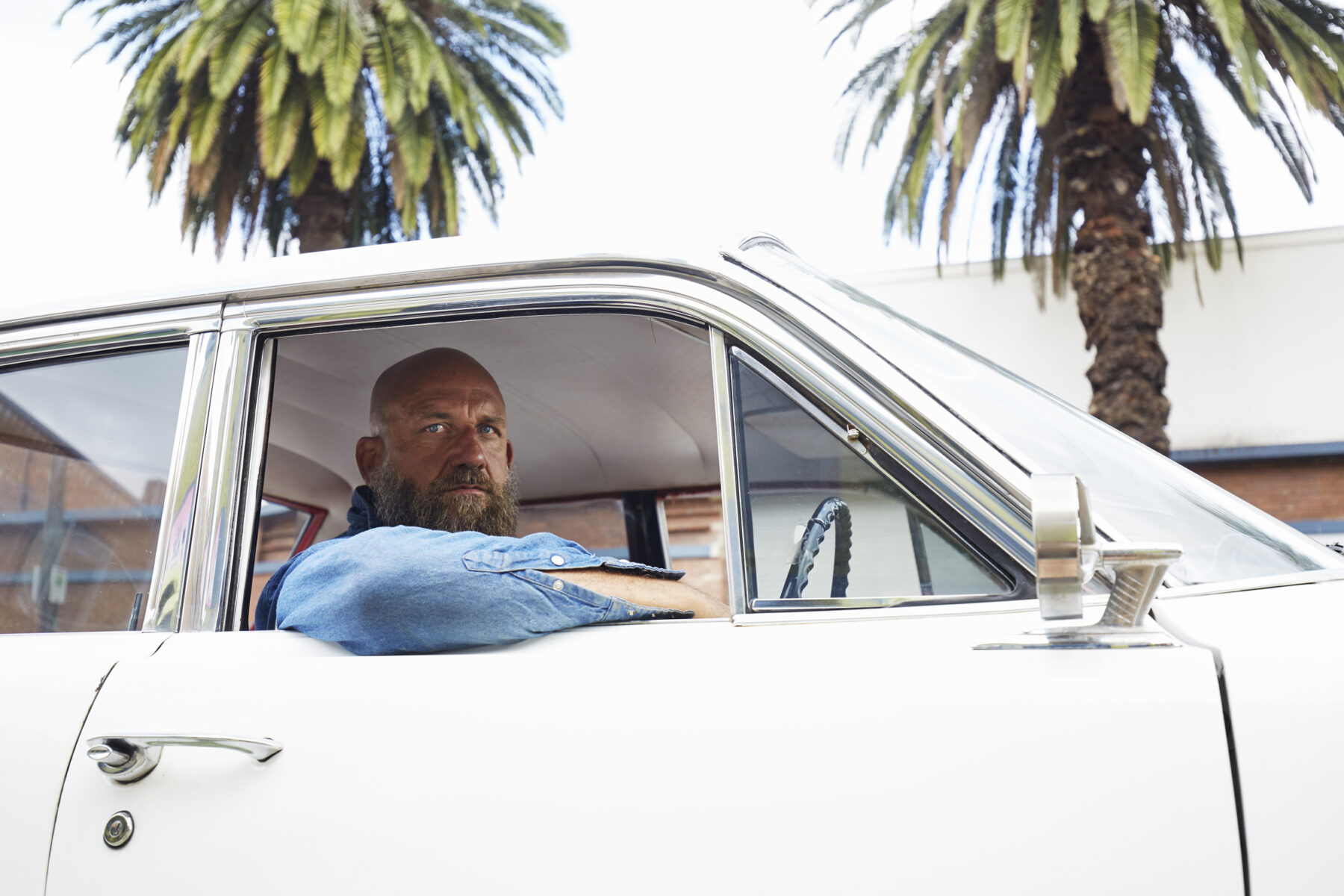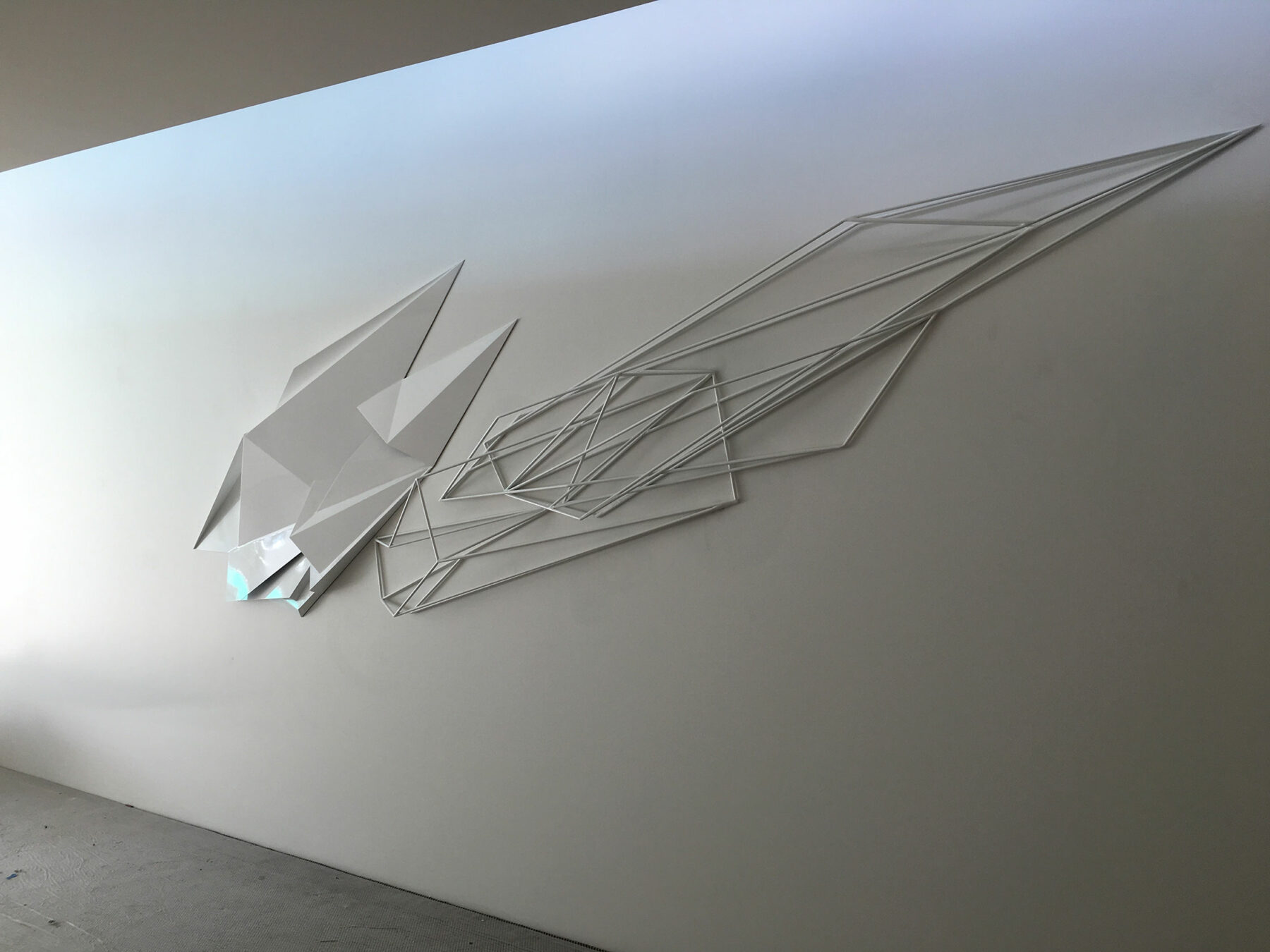Dion Horstmans ricochets around his warehouse for the duration of the interview. “This is kind of how I roll,” he says, chuckling. “I ping! I’m here, I’m over there, I don’t have a fucking pause button but when I’m off, I’m off.”
The workplace of the New Zealand-born, Sydney-based sculptor is a large, high-ceilinged space in an industrial cul-de-sac of Sydney’s inner west, its interiors a rough patchwork of brick, iron and plywood, with high set windows letting natural light stream in from above. Evidence of Dion’s creations is everywhere: mounted on the walls, stacked on shelves, hidden under sheets or lying dismembered on bench tops. Surfaces within the studio are hard, save a couch in the kitchenette, so the echo of his voice bounces about the space after him.
Dion lifts boxes and flicks through drawings; he clears, he cleans, he re-arranges, all whilst talking animatedly. It may seem like a warrior sized ping-pong ball has been let loose at random but everything is done with purpose and efficiency. In fact, if you could trace his lines of movement throughout the space during the interview, the drawing would probably end up looking something very like the angular sculptures he’s become known for, a parallel which would probably satisfy Dion, who takes care to explain how each of his works is a continuity, reflection or developed fragment of one that’s come before it.
This portrait is part of our ongoing collaboration with ZEIT Online. Head over to ZEIT Magazin Online to see more images and further insights on Dion.





“See that white sculpture on the shelf? I’ve cut that up and I’ve put it into a black reflective bath to make this,” he says moving from the sculpture towards a nearby print. “If you flip that around, there’s the sculpture. I’ve just used its reflection… and that physical sculpture over there is actually the shadow of a different sculpture you know – and it casts its own shadow! So it just keeps on going, this continually growing thing.”
The bold geometric abstractions blooming and duplicating in Dion’s warehouse are in constant demand across Australia, Asia and beyond. The dynamic structures of powdered steel, wood and resin and—of equal importance—the fascinating shadows they cast, are commissioned for residential homes, gallery exhibitions, commercial businesses and public spaces, the largest of which an enormous eighty-five-metre long network of yellow steel connecting two skyscrapers, that dances above the heads of pedestrians in Melbourne’s Collin’s Square.
“I’m a social animal but this is the meditative part of my life, the slow down. Otherwise I’m just fucking nuts.”
The sculptures evoke a sense of movement and pace, which is exactly what has gone into their creation. It’s a labor-intensive process which Dion describes as, “Definitely a winter sport. Working with steel and welding and grinding, it gets hot, really fucking hot.” Despite heat he works fast, and usually alone. “I’m very much hands on. There’s no one else here in the workshop with me, it’s my thing, and I’m out here on my own all day.” Ten hour days, six days a week in fact. “I don’t even think about it though. I’m a social animal but this is the meditative part of my life, the slow down. Otherwise I’m just fucking nuts.”









There are low shelves in the warehouse kitchenette stacked with an eclectic collection of books and magazines, from a huge and ancient-seeming leather-bound encyclopaedia to children’s storybooks to ‘lads mags’ from the nineties. Dion pulls a notebook from the shelf and begins to flick through at feverish pace. “I can fill one of these in an hour. I find a blank page terrifying; I have to fill it. Here, have a look.” He passes over a notebook full of curved and voluptuous abstract drawings. “Careful though, some porn is probably going to fall out.” Sure enough torn pages from magazines picturing semi naked ladies soon drift out of the well-used notebook—and now the sweeping lines seem less abstract.
Dion is a man with a surplus of both physical and creative energy which, for better or worse, simply has to be burned. “If I don’t make things and I don’t train, I get a bit lost,” he admits. This awareness makes him both proactive and prolific in his work, his racing mind held back in the realisation of its ideas only by certain physical and logistical limitations.
“You can only work so fast. My hands can only move so fast and I get tired and I get hungry and I get hot. All those basic human factors just slow me down,” he explains, with amusing frustration at his own humanity. “See that yellow piece?” he continues, pointing to a sculpture on a wall. “Over Christmas I toyed with the idea of making that fifteen metres tall. So I thought, if that was fifteen tall it would be eighteen long and seven deep which means I need cranes, so my head started buzzing like and I started thinking about space. OK, I could buy some land further out instead of going east of Nowra I could go west of Nowra into the foothills and I could buy some land and I could buy some cranes. And I thought yeah then I could get some machinery I like machinery—then it’s like woah woah woah, slow down, handbrake.”
Casting Shadows with Dion’s Angular Sculptures
A selection of exhibited and commissioned works
The tug-of-war between Dion’s hyperactive mind and the boundaries of his reality results in the non-linear creative process which has become a defining feature of his work. In some cases it’s a commission which forces him to rewind and restructure his ideas. “Especially for residential commissions, people will usually see something I’ve already created and want a piece in the same vein.” By being forced to recreate old ideas, Dion is going back through the motions of making a piece, which gives him time to think of ways to subvert it into something new. “The easiest way for me to describe my creative process is two steps forward, one back.”
Dion makes a daily pilgrimage to his warehouse each morning from the home in Bondi he shares with his wife Grace. Traveling extensively in his younger years, he settled in Sydney. He then worked in set design for the film industry for nine years before plunging into the life of an artist proper around 2006. Bondi is home and it’s the beach which truly holds Dion captive. “I love the ocean. I grew up between New Zealand and the Cook Islands and my heritage is Polynesian, so I need that ocean fix. Bondi is a proper ocean beach, just fifteen minutes from the CBD—that’s wild, that’s fucking wild!”



“A swim in the ocean is totally revitalizing,” he elaborates, “because you’re jumping into something that’s living. It’s a massive, live organism that’s part of the planet and you’re jumping right into it. That’s about as close as you and I can get to earth without physically hugging it.”
Despite appreciating ‘the good life’ that Bondi can provide, Dion is wary of its tendency to hedonism. “I’ve felt in the last couple of weeks life’s been getting a bit easy. It’s too easy to have a beer at lunch and then I think OK, why not have a joint…I’ve got a real solid grip on that part of my life, I don’t have a drug problem anymore, or an alcohol one, but in summer it’s hard to not have a beer. And because it’s the silly season I start dabbling a bit. I let rip and have a little play, but then I find—not that I want to pick up drugs again like I used to—but I start getting lazy, I find it harder to get motivated to come out here.”
For someone whose modus operandi is to channel creative energy into productivity, laziness is to be avoided at all costs. Dion makes no excuses for himself when he’s not creating and is somewhat scornful of artists who do. “I don’t believe in ‘inspiration’ as a word. A lot of artists will say ‘I’m not feeling inspired’ but I would just say I’m feeling lazy. Then there’s that other excuse that artists pull out, ‘I don’t have the space’. It’s weak. Not part of my language.”





Dion speaks with the bluntness of one who has learned the hard way how to be strong. At the age of twenty-two, he had to learn to walk all over again after free-falling onto concrete from the height of fifteen metres. “It hurt. It really fucking hurt,” he says superfluously of the fall that should have killed him. As well as his rigorous physical training, Dion has also learned to be emotionally robust. “As an artist there’s one thing I have learned—you have to be super thick-skinned.”
“Being a practicing artist is a pretty self-indulgent existence in life and I’m really aware of that.”
“I mean, every time I open a show I’m still terrified no one will turn up. That doesn’t go away. Anyone who says they’re not nervous is either lying or just arrogant. I’m really proud and I work fucking hard but I’m humbled by the fact that I’m allowed to do it. Being a practicing artist is a pretty self-indulgent existence in life and I’m really aware of that. I’m lucky, I am really fucking lucky and I’m not ashamed to admit that and to honor that.”
Dion’s ambition will soon take him to Los Angeles, where he plans to set up for three-to-six months a year, once his 16-year-old daughter finishes her HSC and stops running circles around him, as he puts it.









Dion anticipates his bread and butter will be residential commissions in L.A. but is especially drawn there by the opportunity to network, meeting “the right architects and designers” that will open doors for public works in cities like Dallas, Chicago, San Francisco and New York. “My five year plan is to be established in the States, and after America: conquering the world.” Dion speaks casually of world domination, but you can tell he means it.
Our thanks to Dion Horstmans for his hospitality, honesty and slightly warm beer.
You can find his more of his work here.
For more FvF portraits in and around Sydney, Australia, see here.
Photography: Michael Wickham
Text: Jordan Rahlia








